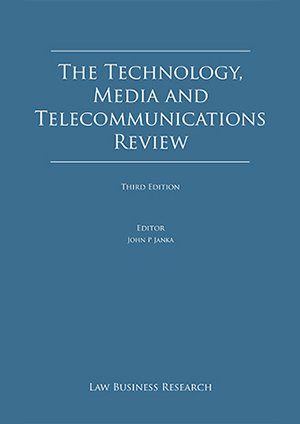This fully updated fifth edition of The Technology, Media and Telecommunications Review provides an overview of the evolving legal constructs that govern the issues facing lawmakers and regulators, as well as service providers and new start-ups, in 29 jurisdictions around the world.
As noted in the previous edition, the pervasive influence of internet and wirelessbased communications continues to challenge existing laws and policies in the TMT sector. Old business models continue to fall by the wayside as new approaches more nimbly adapt to the shifting marketplace and consumer demand. The lines between telecommunications and media continue to blur. Content providers and network operators vertically integrate. Many existing telecommunications and media networks are now antiquated – not designed for today’s world and unable to keep up with the insatiable demand for data-intensive, two-way, applications. The demand for faster and higher-capacity mobile broadband strains even the most sophisticated networks deployed in the recent past. Long-standing radio spectrum allocations have not kept up with advances in technology or the flexible ways that new technologies allow many different services to co-exist in the same segment of spectrum. The geographic borders between nations cannot contain or control the timing, content and flow of information as they once could. Fleeting moments and comments are now memorialised for anyone to find – perhaps forever.
In response, lawmakers and regulators also struggle to keep up – seeking to maintain a ‘light touch’ in many cases, but also seeking to provide some stability for the incumbent services on which many consumers rely, while also addressing the opportunities for mischief that arise when market forces work unchecked.
The disruptive effect of these new ways of communicating creates similar challenges around the world: the need to facilitate the deployment of state-of-theart communications infrastructure to all citizens; the reality that access to the global capital market is essential to finance that infrastructure; the need to use the limited radio spectrum more efficiently than before; the delicate balance between allowing network operators to obtain a fair return on their assets and ensuring that those networks do not become bottlenecks that stifle innovation or consumer choice; and the growing influence of the ‘new media’ conglomerates that result from increasing consolidation and convergence.
These realities are reflected in a number of recent developments around the world that are described in the following chapters. To name a few, these include liberalisation of foreign ownership restrictions; national and regional broadband infrastructure initiatives; efforts to ensure consumer privacy; measures to ensure national security and facilitate law enforcement; and attempts to address ‘network neutrality’ concerns. Of course, none of these issues can be addressed in a vacuum and many tensions exist among these policy goals. Moreover, although the global TMT marketplace creates a common set of issues, cultural and political considerations drive different responses to many issues at the national and regional levels.
I would like to take the opportunity to thank all the contributors for their analytical input into this publication. In the space allotted, the authors simply cannot address all of the numerous nuances and tensions that surround the many issues in this sector. Nevertheless, we hope that the following chapters provide a useful framework for beginning to examine how law and policy continues to respond to this rapidly changing sector.


